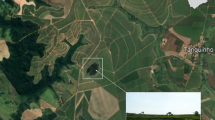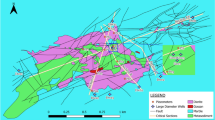Abstract
The purpose of this study is to investigate the changes in electric current, physiochemical properties (such as pH, electrical conductivity), and amount of salt content during the process, where stainless steel electrodes are used and the required power consumption is determined. Also, the ongoing settlement of the dredged sediments during the electrokinetic stabilization is also presented herein. This study shows how application of electric current affects the properties of the dredged mud. Electrokinetic stabilization is a method of improving soils by application of electric current to the soil through electrodes that was introduced by Casagrande in 1949. However, due to the complexity and lack of standard design it’s not a preferable option for geotechnical engineers to use. The type of electrodes and the type of drainage changes the efficiency of the method as a result of changes in soil resistivity. In this bench scale laboratory study, electrokinetic stabilisation is carried out in a cylindrical Perspex cell where the effect of stainless steel electrodes along with providing a double drain condition is investigated through changes in settlement, water content, soil resistivity, and the power consumption. As a result it is shown that significant amount of dewatering is achieved. The electrokinetic sedimentation of the dredged mud accelerated up to 20 times faster than self-weight sedimentation. The change of physiochemical properties of the dredged mud shows permanent changes in the soil structure. Placement of cathode at the bottom result in an increase in resistivity of the dredged mud and generation of the cracks near the cathode at the bottom which interrupts the flow of electric current through the soil mass.
Similar content being viewed by others
References
Azam, S., Scott, J. D., and Jeeravipoolvarn, S. (2007). “When does a slurry become a soil? Geotechnical News.” BiTech Publishers Ltd., Vol. 25, No. 3, pp. 44–46, DOI: 10.1007/s10706-011-9453-6.
Citeau, M., Larue, O., and Vorobiev, E. (2011). “Influence of salt, pH and polyelectrolyte on the pressure electro-dewatering of sewage sludge.” Water Research, Vol. 45, pp. 2167–2180, DOI: 10.1016/j.watres.2011.01.001.
Eide, O., Bjerrum, L., and Moum, J. (1967). “Application of electroosmosis to a foundation problem in a norwegian quick clay.” Geotechnique, pp. 214-235, DOI: 10.1680/geot.1967.17.3.214.
Kynch, G. J. (1952). “A theory of sedimentation.” Transactions of the Faraday Society, Vol. 48, pp. 166–176, DOI: 10.1039/TF9524800166.
Lefebvre, G. and Burnotte, F. (2002). “Improvements of electroosmotic consolidation of soft clays by minimizing power loss at electrodes.” Canadian Geotechnical Journal, pp. 399–408, 10.1139/t01-102.
Liaki, C., Rogers, C., and Boardman, D. (2010). “Physico-chemical effects on clay due to electromigration using stainless steel electrodes.” Journal of Applied Electrochemistry, pp. 1225–1237, DOI: 10.1007/s10800-010-0096-8.
Lo, K., Inculet, I., and Ho, K. (1991). “Electroosmotic strengthening of soft sensitive clays.” Canadian Geotechnical Journal, pp. 62-73, DOI: 10.1139/t91-007.
Loch, J., Lima, A., and Kleingeld, P. (2010). “Geochemical effects of electroosmosis in clays.” Journal of Applied Electrochemistry, pp. 1249-1254, DOI: 10.1007/s10800-010-0098-6.
Lyklema, J. (1995). Fundamentals of interface and colloid science (Vol. 2, p. 3.208). San Diego: Academic Press. 10.1016/j.colsurfa.2004.03.002.
Malekzadeh, M., Lovisa, J., Sivakugan, N., and Mathan, B. (2014). Physiochemical changes during electrokinetic stabilization of dredged mud. In: 7th international congress on environmental geotechnics. Melbourne: Engineers Australia, pp. 1473–1494, ISBN: 9781922107237.
Rozas, F. and Castellote, M. (2012). “Electrokinetic remediation of dredged sediments polluted with heavy metals with different enhancing electrolytes.” Electrochimica Acta, Vol. 86, pp. 102–109, DOI: 10.1016/j.electacta.2012.03.068.
Shang, J. Q. (1998). “Electroosmotic enhanced preloading consolidation via vertical drains.” Canadian Geotechnical Journal, Vol. 35, No. 3, pp. 491–499, DOI: 10.1139/t98-018.
Author information
Authors and Affiliations
Corresponding author
Rights and permissions
About this article
Cite this article
Malekzadeh, M., Sivakugan, N. Double drain electrokinetic stabilization of dredged mud using stainless steel electrodes and application of surcharge. KSCE J Civ Eng 21, 2615–2621 (2017). https://doi.org/10.1007/s12205-017-0975-1
Received:
Revised:
Accepted:
Published:
Issue Date:
DOI: https://doi.org/10.1007/s12205-017-0975-1




